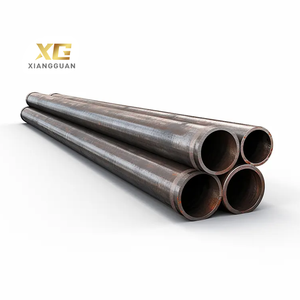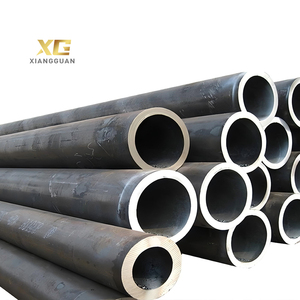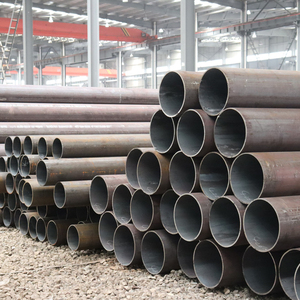(1019 products available)





























































































































































































The types of used ERW pipe mills for sale can generally be divided into two categories according to their manufacturing feature and usage: the primary means of pipe production and the kind of pipe produced, as discussed below.
Two manufacturing methods are prevalent: the cold-formed used ERW pipe mill and the hot-formed used ERW pipe mill. Mill lines that produce pipes through high-frequency induction heating (HF) for ERW pipes due are known as 'high-frequency used ERW pipe mills.' They are also a kind of hot-formed mills. Induction coils heat strip edges for forming and welding. These mills have welder stations and a softening station for the weld area. Other specifications may vary according to pipe sizes and wall thickness.
A cold-formed used Erw pipe mill makes pipes from cold-rolled steel strips that are cut, bent, and welded into shape at room temperature. These mill machines are typically used to create pipes with thinner walls and smaller diameters and produce pipes that are more precise in diameter than hot-formed mills. Its components include uncoilers, levelers, shears, edge milling machines, circlip equipment, formers, roll sets, high-frequency ERW welders, sizing sections, flying shears, pipe plugs, water tanks, cooling systems, thread machines, stitchers, inspect, and roll off systems.
High-frequency used ERW pipe mills produce large quantities of pipes quickly and are also more affordable than colder-forming mills. Nevertheless, the latter are useful for making specialized pipes with thicker walls and larger diameters.
Manufacturing used ERW pipe mills produce pipes from steel and other materials, such as plastic. These are, respectively, used steel ERW pipe mills and used plastic pipes. The former are used more in construction and support underground facility operations than other industries. The latter are crucial for the water supply industry in agricultural and municipal sectors.
Used plastic pipe mills manufacture pipes from raw plastic using a fusion technique. The plastic is heated until it melts, then formed into its final shape through a die. Once cooled, it maintains the shape. There are three main types of used plastic pipe mills: PVC, HDPE, and PPR. PVC plastic pipes can be rigid or flexible, with the rigid kind used for water transportation. Flexible PVC is used in the electric industry for housing electrical wires. High-Density Polyethylene (HDPE) pipes are suitable for high-pressure applications, while Polypropylene Random Copolymer (PPR) pipes are used for water supply systems in buildings. Other kinds of plastic pipes include Polyethylene (PE), Polyethylene, Chloro (PVC-C), and Fiber Reinforced Plastic (FRP) ones.
Many specifications must be considered when determining the capabilities of an used ERW pipe mill. Some key specifications include the dimensions of the pipes it is capable of producing, as well as the strength of the material it can handle. The diameter range for used ERW pipe mills usually starts from 1/2' up to 20', while the wall thickness range is between 0.3 mm and 10 mm. Also, the material used should be mild steel, stainless steel, carbon steel, and alloy steel. In addition to this, the length of the pipes can vary from 1m to 12m and more. With advancements in technology, it is now possible to manufacture longer lengths as well.
Furthermore, the machine's production capacity is another important specification to consider; this generally varies between 1 ton and 50 tons per day. Additionally, the tolerances of an ERW pipe mill are usually within ± 0.5mm for the outer diameter and ± 1.0mm for the wall thickness. An essential specification buyers should keep in mind is the type of coil used. Steel strip coiles of various widths are generally used to feed the mill.
Like any other machine, proper maintenance of an ERW pipe mill prolongs its life and keeps it in great working condition. Regular inspection and cleaning of welding equipment is the key to preventing most breakdowns. It's important to keep a lookout for parts that need lubrication or are worn out like chains, sprockets, bearings, and drive rolls; these should be closely examined often. Additionally, the bearings should be greased at least once a month, even if the machine is not in use, to prevent them from seizing up. Oil chain drives and roller stands frequently so that they do not rust and remain smooth.
Cleaning the welds regularly can prevent overheating from buildup, which can cause faster parts wear and tear. It is normal for the electrode to wear out, but just like other parts, it should be regularly inspected and replaced if there is noticeable uneven wear. The alignment of the welding tips is essential for proper and even current distribution throughout the pipe. Misaligned or worn-out electrodes result in uneven and inconsistent welding, which can cause the weld to break. These parts should be regularly inspected and maintained for smooth operations.
Second-hand ERW pipe mills have a variety of applications in the industrial production field.
Oil and Gas Industry:
The used ERW pipe mill production line exports to the oil and gas industry. The pipe produced meets the requirements of the industry in terms of specifications and standards.
Construction:
Construction used ERW pipe mills are usually employed to produce large quantities of pipes. The pipes have multiple uses in the field of construction, such as structural pipes, scaffolding pipes, etc.
Automotive Industry:
Automobile used ERW pipe mills may produce automobile parts, such as exhaust pipes, chassis, etc. These parts require high precision and good quality welding technology.
Machinery Manufacturing:
Used tube mills may produce mechanical parts, such as axles, shafts, etc. These parts require high strength and precise dimensional control.
Furniture Production:
Furniture manufacturing companies use second-hand ERW pipe mills to produce metal furniture such as office chairs, workbenches, etc.
Transport Industry:
In the transportation industry, used ERW pipe mills can be employed for the production of railway tracks, guardrails, and other pipe products connected to transportation facilities.
Manufacturing of home appliance:
Home appliance manufacturers can utilize second-hand pipe mills to produce refrigerators, washing machines, and other home appliance components such as pipes and brackets.
Industrial machinery buyers should consider various factors when purchasing pipe mills. The following explains some of these factors in detail.
Production Capacity
The first factor buyers must consider is the production capacity of the pipe mill. The production capacity of a mill determines how much it can produce in a specific time period. When choosing a pipe mill, buyers need to think about their project's needs and the expected demand. A pipe mill with higher production capacity can meet large-scale demands but may be more expensive. On the other hand, a mill with lower capacity may suffice for small projects and cost less. However, buyers should ensure that the mill's capacity can meet current and future demands.
Pipe Sizes and Specifications
The pipe size and specification a project needs is another important consideration for buyers. ERW pipe mills come in different specifications, and selecting the wrong one can negatively impact a project's success. When choosing a pipe mill, buyers should ensure that the mill can produce pipes with the right size and specifications for their intended use. The specifications may include wall thickness, straightness, surface finish, and dimensions. Also, the property and performance of the material can be affected by the specifications.
Technical Features and Automation
Another factor impacting a pipe mill's suitability is its technical features and level of automation. Pipe production is a complicated process that requires high precision and efficiency. As a result, modern mills have advanced technical features that improve productivity and product quality. These features may include computer numerical control (CNC), automatic feeding systems, and integrated quality control. Such high-tech features usually make the mills more expensive. Buyers should ensure that the mill's technical features match their production requirements.
Energy Efficiency and Operating Costs
Buyers should consider a mill's energy efficiency and operating costs. These factors can affect a project's sustainability and profitability. A pipe mill uses less energy and has lower operating costs, and it helps to cut down on production costs. This benefit comes either through its design, efficient machinery, or modern technology. An energy-efficient mill has a positive impact on the environment. Additionally, the operating cost of the pipe mill can affect the return on investment for the project.
Q1. How does the used erw pipe mill work?
A1. An ERW pipe mill works by roll forming flat steel to form a round, box, or other shapes. Welders then weld the edges to create a seam. The seam may then be shaped or not further to create the required pipe.
Q2. What are the specifications of a used erw pipe mill?
A2. The specifications of an ERW pipe mill include the meant size and range of pipes it can produce. The specification also includes the material thickness range. The specifications may also include the line speed or the length of the pipe produced per minute.
Q3. What is the difference between erw and gf pipes?
A3. The main difference between ERW and GF pipes is the way they are produced. Gas fluorinated pipes are made using a fluorination process that makes the pipes more resistant to gases. Gas fluorinated pipes are also more flexible than ERW pipes.
Q4. What are the advantages of a used erw steel pipe mill?
A4. Used ERW steel pipe mills have many benefits. They include the efficient production of pipes at a lower cost. The mills are also very versatile and can produce pipes of different shapes for various applications.